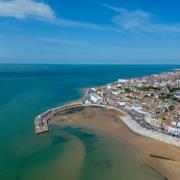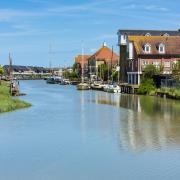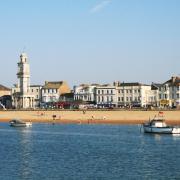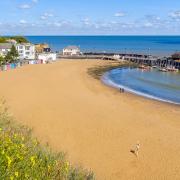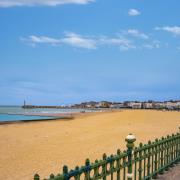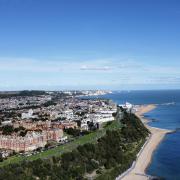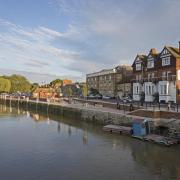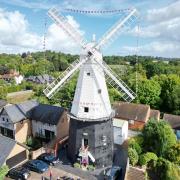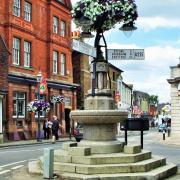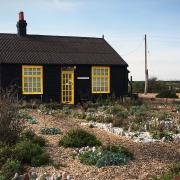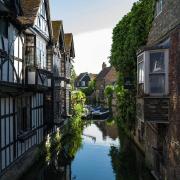The National Trust’s celebration of the 50th anniversary of its Neptune Coastline Campaign this year offers the perfect motivation for an investigation of Kent’s famous White Cliffs
Dover may not be one of Kent’s prettiest towns but, sitting in the dramatic landscape of the White Cliffs, it is certainly among its most historic.
When ancient sea captains beheld the shimmering chalk edifices while attempting to navigate the Dover Strait’s treacherous waters, they called them what was to become Britain’s earliest-known name, ‘Albion’ (from the Latin alba, ‘white’).
And when Julius Caesar mounted his first invasion of these islands 2,000 years ago, it was on Dover’s heights that the Britons assembled their army. Caesar, with his fleet waiting in the waters below, soon realised that the daunting rocks were no place to stage a forced landing and had to launch another, only partially successful, effort after sailing further north to a beach at Walmer.
Not for nothing was Dover to became known as ‘the lock and key of England,’ with Dover Castle, built by Henry II, the largest in Europe.
But if Dover has been an obstacle for potential invaders, the sight of it has also been a welcoming source of comfort for those returning from abroad, never more poignantly than for the servicemen coming home after the evacuation of Dunkirk.
And who hasn’t stood on the ferry deck as the boat drew ever closer to the harbour and not had a few bars of Vera Lynn’s White Cliffs of Dover waft through their minds?
Even so, looking at the cliffs from afar is one thing, exploring them is another, and many people may be deterred from walking the cliffs by the thought that they present some kind of wearying obstacle.
In reality, even though they are 350ft high at their loftiest point, a stroll along them follows a modest gradient, and the reward is some truly spectacular views, fully equivalent to those at Beachy Head or along the Cornish coast.
And the National Trust celebration of the 50th anniversary of its Neptune Coastline Campaign this year offers the perfect motivation for an investigation.
When the Trust launched its campaign in 1965, the Dover cliffs were among its first acquisitions. While the prime motivation was to protect choice areas of the British coast from being bought up for development, another was to ensure that the public had access to large stretches which were valued for their scenic, historic and wildlife interests.
Unsurprisingly, the startlingly white cliffs at Dover were seen as a trophy site and remain one of the most important areas in the 742 miles of coast around England, Wales and Northern Ireland which the Trust now owns or manages. The White Cliffs of Dover walk runs for some four miles (6.4km) along the cliff tops, from the National Trust’s White Cliffs Visitor Centre to South Foreland Lighthouse.
One way to experience the cliffs in all their staggering, forbidding enormity is to approach from below, via the terrace of houses at East Cliff, behind the port.
The chalk edifice is intimidatingly close at this point, rising up sheer behind the row of tiny cottages as if trying to suffocate them of air. It’s an awesome, unnerving spectacle, as gulls circle high above.
On the grassland beside the Visitors’ Centre car park, as you look back over your shoulder the outline of Shakespeare Cliff, greyly silhouetted in the haze, looks like the head of giant whale, rearing up behind Dover’s Western Docks.
This is also a good spot to appreciate the impressive extent of Dover Castle’s immense fortifications, occupying a nearby hilltop. Seaward, you can watch the comings and goings of the ferries as they carefully inch their way beside the jetties.
But as you head eastward, leaving behind the hum of the port engines, you become aware of the birdsong, especially the everlasting twitter of the skylarks, and the meadow pipits.
The chalk downland along the cliffs is designated as an Area of Outstanding Natural Beauty and a Sight of Special Scientific Interest (SSSI) due to the array of plant and insect life which thrives here.
Small, delicate plants such as knapweed, horseshoe vetch, and early spider orchids thrive, as do Adonis blue and chalkhill blue butterflies. The latter feed on the horseshoe vetches, but these plants, like so much other dainty chalkland flora, get crowded out by coarser vegetation.
It’s for this reason you will see Exmoor ponies and Hebridean sheep grazing, as a natural method of scrub control.
The scenery opens out spectacularly above Langdon Hole, although the undulations are surprisingly accessible, despite the dramatic downward sweeps and curves of the paths.
Yet the cliff edges have a jagged, almost untameable quality. On the ledges a colony of kittiwakes, in national decline as a species, breeds here each year.
Some people up here seem to take enormous risks. I have seen one man with two largish dogs on a lead standing by the cliff edge. It only needed one of his dogs to spook at something, and he’d have been over the side. Others seem to delight in sitting perched on the edges despite in parts, alarming gaps in the turf revealing sheer drops to the sea far below.
Phil Dyke, the Trust’s Coast and Marine Advisor, says: “We tend to see dramatic failures of specific sections of cliff from time to time, in response to weather, ground water conditions, freeze and thaw, as well as the sea nibbling away at the base.”
The ocean itself, mill pond still on a gentle day with only a slight breeze, is deceptive. The Strait of Dover is not only the busiest sea lane in the world, with more than 400 vessels passing through the English Channel a day, but historically it is one of the most treacherous too.
The White Cliffs have their own wreck, the remains of the steam ship SS Falcon, seen from the cliffs overlooking Langdon Bay, where she beached in 1926.
And old South Foreland lighthouse may look jaunty enough, with its castellated tower and spotless coat of white paint, but it was built because of the proximity of the treacherous Goodwin Sands, the 12-mile long, five-mile wide sandbank which has been the nemesis of 2,000 vessels.
In the First and Second World Wars this stretch of coast was in the frontline of hostilities and the Langdon Lights was one of the searchlight batteries set into the cliffs to illuminate ships entering the bay.
In 2012, the National Trust raised £1.2m via a public campaign to acquire a 0.8 mile of stretch of the White Cliffs, the “missing link” between the Visitor Centre and the South Foreland Lighthouse.
Since then conservation work has continued apace, and there’s a new sight for walkers. The uncovered concrete Sound Mirror on the side of the hill at Fan Bay is believed to be one of the oldest acoustic early warning devices ever constructed (it dates from 1917) to give advanced notice of approaching enemy aircraft.
Covered up in the 1970s because it was regarded as an eyesore, the Trust is also restoring the adjoining tunnels to enable visitors to explore inside.
It’s a fitting location, given that Marconi conducted his early experiments in radio communications at South Foreland, just over the brow, making the world’s first ship-to-shore radio transmission here back in the 1890s.
And it’s one more reason for enjoying the White Cliffs of Dover walk in this very special anniversary year.
READER COMPETITION
A lavishly illustrated, 384-page hardback book by Claire Gogerty, the former editor of Coast magazine, The National Trust Book of the Coast: From Lindisfarne to the Lizard, has been published by the National Trusts to mark the 50th anniversary of the Neptune Coastline campaign.
Along with descriptions of coastal walks, it explains the wildlife, natural habitats, historical links, and other activities to be explored in such dramatics places as secluded coves of Cornwall, Northumberland’s dunes and the Giants’ Causeway, Count Antrim. The Kent coast is also explored, with particular attention paid to the White Cliffs.
Readers can purchase a copy at the National Trust’s for £20 at the online shop: http://shop.nationaltrust.org.uk/the-national-trust-book-of-the-coast/p6317
Kent Life has teamed up with The National Trust to offer one lucky a copy of The National Trust Book of the Coast: From Lindisfarne to the Lizard.
To be in with a chance of winning, just answer this simple question:
The National Trust launched its Neptune Coastline Campaign in:
1945
1955
1965
Write your answer on a postcard and send it to: The National Trust Competition, Kent Life, Archant Kent, 81 Station Road, Ashford TN23 1PP. Don’t forget to include your name, address and a daytime telephone number on your entry.
Alternatively, you can send your answer in by email. Please send it to editor@kent-life.co.uk, with The National Trust Competition in the subject line, including your name, address and a daytime telephone number.
Closing date: 29 May 2015
The editor’s decision is final. Usual Archant competition rules apply.
Find out more
For more details on things to see and do on the White Cliffs: www.nationaltrust.org/whitecliffs
For prices and opening times for Dover Castle, in the care of English Heritage:
www.english-heritage.org.uk/visit/places/dover-castle
n




